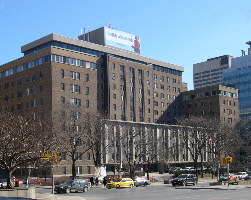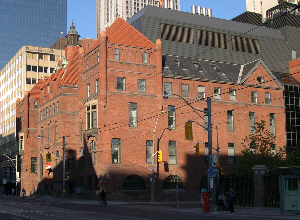Over the years “SickKids’” Hospital has been located in four buildings, from the first six bed one to the present great institution at the corner of University Avenue and Elm Street.

SickKids’ Hospital, 555 University Avenue
In 1875, a group of Toronto women led by Elizabeth McMaster, rented an 11-room house in downtown Toronto for $320 a year, and set up six iron cots. They declared stated that this would be a hospital “for the admission and treatment of all sick children.” On April 3, they got their first patient, a scalding victim, called Maggie. Forty four patients were admitted to the hospital in the first year, and sixty-seven others were treated as outpatients. The demand grew and in 1876, the hospital moved to a larger building with 16 beds which quickly proved too small.
In 1891, it moved to the impressive four-story, 320-bed facility at the corner of Elizabeth and College Streets, which is still standing. The Toronto Historical Board plaque on the building reads in part: “Designed by the architectural firm of Darling and Curry and built of red sandstone, the Victoria Hospital for Sick Children opened in May 1892. It was the first hospital in Canada designed exclusively for paediatrics. Through the generosity of its benefactor, John Ross Robertson, the hospital incorporated the most innovative techniques available, such as x-rays in 1896 and a milk pasteurization plant in 1909. The Hospital for Sick Children vacated the building in 1951.” For a while in the 1990s this building housed the Canadian Red Cross Regional Blood Centre. While the Toronto city council requested that it be named Victoria Hospital for Sick Children, which name is emblazoned above the front door, the new name was never officially adopted.

Victoria Hospital for Sick Children, College Street
The staff of this hospital led the fight in Canada for compulsory pasteurization of milk. In 1908, the first milk pasteurization plant in Canada was established here, thirty years before it became mandatory. The Nutritional Research Laboratory was established in 1918. The nutritional research of Drs. Alan Brown, Fred Tisdall, and Theo Drake led to the development of Pablum, a precooked baby cereal, that saved thousands of children from death and disease.
On February 4, 1951, the hospital moved to its current location at 555 University Avenue, occupying the grounds where the childhood home of actress Mary Pickford once stood. At the same time, there was a switch in emphasis from nutritional research to the repair of congenital defects. The hospital also pioneered celebrated surgical procedures to repair dislocations and correct heart defects. In the 1960s, SickKids opened one of the first intensive care units in North America devoted exclusively to the care of critically-ill new-born and premature babies. Advances in genetics have led to the identification and cloning of a number of genes responsible for causing hereditary diseases such as Duchenne muscular dystrophy and cystic fibrosis.
Information from “Toronto Old and New” and the “SickKids” web site.
